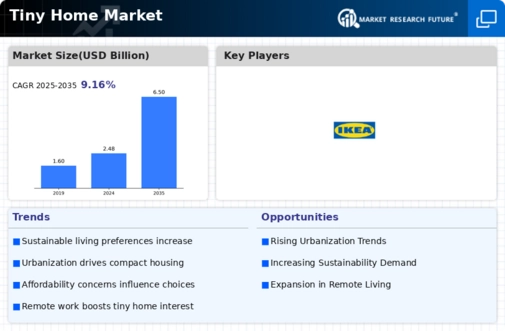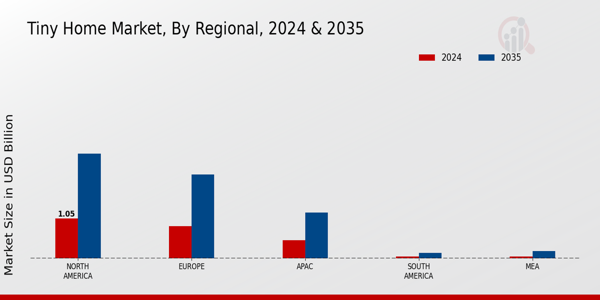Market Growth Projections
The Global Tiny Home Market Industry is poised for substantial growth, with projections indicating a rise from 2.48 USD Billion in 2024 to 6.5 USD Billion by 2035. This growth trajectory suggests a compound annual growth rate of 9.15% from 2025 to 2035. Such figures reflect the increasing acceptance of tiny homes as a legitimate housing option across various demographics. The market's expansion is likely driven by factors such as urbanization, sustainability, and changing consumer preferences. As the industry evolves, it may attract new players and innovations, further enhancing its growth potential.
Changing Consumer Preferences
The Global Tiny Home Market Industry is witnessing a shift in consumer preferences towards minimalism and simplified living. Many individuals, particularly millennials and Gen Z, are prioritizing experiences over material possessions, leading to a growing interest in tiny homes. This demographic shift is characterized by a desire for flexibility, mobility, and affordability in housing. As more consumers embrace the tiny home lifestyle, the market is likely to expand. The anticipated growth to 6.5 USD Billion by 2035 suggests that this trend will continue to shape the industry, as tiny homes become synonymous with a modern, minimalist lifestyle.
Rising Affordability of Tiny Homes
The Global Tiny Home Market Industry experiences a notable increase in affordability, attracting a diverse demographic. With the average cost of a tiny home ranging from 30,000 to 60,000 USD, it presents an appealing alternative to traditional housing. This affordability is particularly significant in urban areas where housing prices are escalating. As of 2024, the market is valued at 2.48 USD Billion, indicating a growing acceptance of tiny homes as a viable housing solution. This trend suggests that more individuals and families are considering tiny homes as a practical choice, potentially leading to a broader market expansion in the coming years.
Urbanization and Space Constraints
Urbanization continues to drive the Global Tiny Home Market Industry, as more people migrate to cities where space is limited. The increasing population density in urban areas creates a pressing need for innovative housing solutions. Tiny homes offer a practical response to these challenges, providing efficient living spaces that maximize utility in small footprints. As cities grapple with housing shortages, tiny homes may emerge as a viable alternative. The projected compound annual growth rate of 9.15% from 2025 to 2035 indicates that the market is likely to expand significantly as urban populations continue to grow.
Sustainability and Environmental Awareness
The Global Tiny Home Market Industry is increasingly influenced by a shift towards sustainability and environmental consciousness. Tiny homes typically utilize fewer resources, produce less waste, and often incorporate eco-friendly materials and technologies. This aligns with the global movement towards reducing carbon footprints and promoting sustainable living. As consumers become more aware of their environmental impact, the demand for tiny homes is likely to rise. The market's projected growth to 6.5 USD Billion by 2035 reflects this trend, as more individuals seek housing solutions that align with their values of sustainability and minimalism.
Technological Advancements in Construction
The Global Tiny Home Market Industry benefits from technological advancements in construction and design. Innovations such as prefabrication, modular construction, and smart home technology enhance the efficiency and appeal of tiny homes. These advancements not only reduce construction time and costs but also improve the overall quality and functionality of living spaces. As consumers increasingly seek modern amenities within compact designs, the integration of technology into tiny homes becomes a key driver. This trend is expected to contribute to the market's growth, as more builders and developers adopt these technologies to meet consumer demands.













Leave a Comment